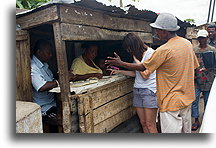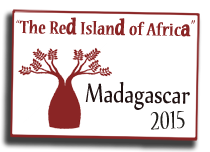Trading precious stones
January 9
After two nights near Isalo we continued our journey west passing through gemstone-rich areas of southern Madagascar. Small mining towns on the way looked richer than the ones we have seen before. Gem dealers palaces dominated in the area. In front of each of these establishments were cars shining from a newly applied wax coat, a stark contrast to the surrounding dust. To show high status and wealth these houses were built entirely of concrete. They had glass windows and decorative balcony railings. All of this seemed very strange because the architectural styles and materials used were almost completely unknown in the local construction industry. These homes were also places where local miners traded their rough colored gems such as sapphires, rubies, etc. There were no large mines with mineshafts in the area. As we saw, gem mining here was simply digging underground tunnels without any safety measures, taking dirt out to the surface and sluicing it in a nearby river.




We stopped in a few of these houses to see what gemstones traded there. The dealer palaces were well guarded but no sale counters could be found there. Roadside wooden shacks however had some precious stones for sale. Did I say precious stones? I should rather say dirt for sale. With our lack of expertise in this field we browsed stones and found that it is better if pick up rocks from the ground under our feet for free instead of buying it from shopkeepers, no new ring for Eva this time.




There are gendarmerie and police checkpoints on roads in almost every village in Madagascar. None of them bothered to stop us, until now. In the middle of nowhere, outside of any settlement, two gendarmes decided to check our documents. We have learned from them that we are missing very important papers. How come, Im sure that we carry all the required documents? I said to the officer. Unfortunately, one mysterious, hard to identify document which does not really exist was required. In order to solve the problem, we will have to give them the biggest local currency bill, 10,000 ariary (4 USD), I was thinking loud after 30 minutes of waiting. The higher in rank gendarme expected the bribe, but insisted on more money. After another 30 minutes and another 10,000 ariary in his pocket, we were free. It was silly to pay this bribe, but I was still learning local unwritten rules. Never again, I hate to pay corrupt officialsI said to myself next time we will play this game differently.




In early afternoon, we reached Tulear (formerly Toliara) on the west coast of Madagascar. The town located exactly on the Tropic of Capricorn is crowded, dirty, has polluted sea and the coast. Here at sea level, it was extremely hot; the temperature was much higher than in other parts of Madagascar we have visited so far. Wind blowing from the Mozambique Channel was like heat from the convection oven, and inside our Pajero we felt like baked chicken. Tractor had broken cabin fan not to mention the A/C. The extreme heat was taking its toll on us. We needed desperately a quiet and cool oasis for a night, but it was not that easy.
All the hotels that we checked in Tulear were disgusting. Finally, we were lucky to find small hotel called Bakuba Concept outside the city. Initially we planned to spend one night, but ended up to be there three. It turned out to be the best of all the hotels we visited in Madagascar.













